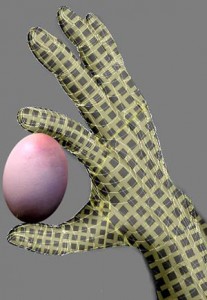Transmetalation bears a resemblance of sorts to transmutation. While the chemists from the University of Oregon aren’t turning lead to gold through an alchemical process they are switching out individual metal atoms, aluminum for indium. From a July 21, 2014 news item on ScienceDaily,
The yield so far is small, but chemists at the University of Oregon have developed a low-energy, solution-based mineral substitution process to make a precursor to transparent thin films that could find use in electronics and alternative energy devices.
A paper describing the approach is highlighted on the cover of the July 21 [2014] issue of the journal Inorganic Chemistry, which draws the most citations of research in the inorganic and nuclear chemistry fields. [emphasis mine] The paper was chosen by the American Chemical Society journal as an ACS Editor’s Choice for its potential scientific and broad public interest when it initially published online.
One observation unrelated to the research, the competition amongst universities seems to be heating up. While journals often tout their impact factor, it’s usually more discreetly than in what amounts to a citation in the second paragraph of the university news release, which originated the news item.
The July 21, 2014 University of Oregon news release (also on EurekAlert), describes the work in more detail,
The process described in the paper represents a new approach to transmetalation, in which individual atoms of one metal complex — a cluster in this case — are individually substituted in water. For this study, Maisha K. Kamunde-Devonish and Milton N. Jackson Jr., doctoral students in the Department of Chemistry and Biochemistry, replaced aluminum atoms with indium atoms.
The goal is to develop inorganic clusters as precursors that result in dense thin films with negligible defects, resulting in new functional materials and thin-film metal oxides. The latter would have wide application in a variety of electronic devices.
“Since the numbers of compounds that fit this bill is small, we are looking at transmetelation as a method for creating new precursors with new combinations of metals that would circumvent barriers to performance,” Kamunde-Devonish said.
Components in these devices now use deposition techniques that require a lot of energy in the form of pressure or temperature. Doing so in a more green way — reducing chemical waste during preparation — could reduce manufacturing costs and allow for larger-scale materials, she said.
“In essence,” said co-author Darren W. Johnson, a professor of chemistry, “we can prepare one type of nanoscale cluster compound, and then step-by-step substitute out the individual metal atoms to make new clusters that cannot be made by direct methods. The cluster we report in this paper serves as an excellent solution precursor to make very smooth thin films of amorphous aluminum indium oxide, a semiconductor material that can be used in transparent thin-film transistors.”
Transmetalation normally involves a reaction done in organic chemistry in which the substitution of metal ions generates new metal-carbon bonds for use in catalytic systems and to synthesize new metal complexes.
“This is a new way to use the process,” Kamunde-Devonish said, “Usually you take smaller building blocks and put them together to form a mix of your basic two or three metals. Instead of building a house from the ground up, we’re doing some remodeling. In everyday life that happens regularly, but in chemistry it doesn’t happen very often. We’ve been trying to make materials, compounds, anything that can be useful to improve the processes to make thin films that find application in a variety of electronic devices.”
The process, she added, could be turned into a toolbox that allows for precise substitutions to generate specifically desired properties. “Currently, we can only make small amounts,” she said, “but the fact that we can do this will allow us to get a fundamental understanding of how this process happens. The technology is possible already. It’s just a matter of determining if this type of material we’ve produced is the best for the process.”
Here’s a citation for and a link to the paper,
Transmetalation of Aqueous Inorganic Clusters: A Useful Route to the Synthesis of Heterometallic Aluminum and Indium Hydroxo—Aquo Clusters by Maisha K. Kamunde-Devonish, Milton N. Jackson, Jr., Zachary L. Mensinger, Lev N. Zakharov, and Darren W. Johnson. Inorg. Chem., 2014, 53 (14), pp 7101–7105 DOI: 10.1021/ic403121r Publication Date (Web): April 18, 2014
Copyright © 2014 American Chemical Society
This paper appears to be open access (I was able to view the HTML version when I clicked).
